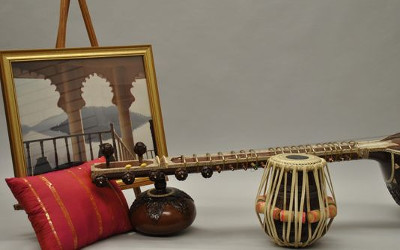AKIPRESS.COM -  For many Western audiences, the music of India means one thing: the sitar. But Indian classical music involves more than that stringed instrument, as versatile as it is, according to USA Today Network.
For many Western audiences, the music of India means one thing: the sitar. But Indian classical music involves more than that stringed instrument, as versatile as it is, according to USA Today Network.
Showing the richness of Indian music is one of the goals of “Sounds of India,” the exhibit on display at the Morris Museum now through October 23. “Sounds of India” offers a variety of instruments from Indian classical music, according to Jody Marcus, who curated the exhibit. That does include stringed instruments.
But the exhibit also features the Tabla (hand drums) and other instruments. Marcus noted that the idea dividing an orchestra into four “families” – strings, brass, woodwinds, and percussion – can actually be traced to India.
Besides instruments, “Sounds of India” offers a variety of costumes, jewelry, and other items associated with Indian dance. “In India, music and dance are so entwined,” Marcus said. “You can’t talk about one without talking about the other.”
“Sounds of India” grew out of an exhibit that the Morris Museum hosted a year ago on Indian clothing. “After that, we talked about what other aspects of Indian culture we could do, and the idea of musical instruments came up,” Marcus said.
Classical Indian music has two main branches: Karnatic and Hindustani. Both are represented in the Morris Museum exhibit. Karnatic music, which comes mainly from southern India, is known for its vocal stylings. Hindustani music, found in northern and central India, is considered largely a showcase for instrumentalists.
Marcus noted that the music represented by “Sounds of India” is different from the music that is featured in Indian cinema (popularly known as “Bollywood”).
“The Indian music in movies tends to be a bit Westernized,” Marcus said. “What we’re dealing with is Indian classical music.”
However, Marcus pointed out that the Indian approach to music – even classical music – takes a different turn from the Western version of classical music.
“Indian classical music allows for a great deal of improvisation,” Marcus said. “We try to compare that with the highly structured music of the West.”
Even a visitor with no knowledge of the nuances of Indian music is likely to be impressed by the exhibit, Marcus said. “These instruments are beautiful to look at,” she said. “There are inlays of ivory. The designs are beautiful.”
The display also has traditional Indian rugs, on loan from J & S Designer Flooring.
In connection with “Sounds of India,” the Morris Museum is hosting a workshop on Indian drumming on Saturday, August 27. The interactive program will be led by dancer-percussionist Jim Won from the Taalim School of Indian Music in Edison.
